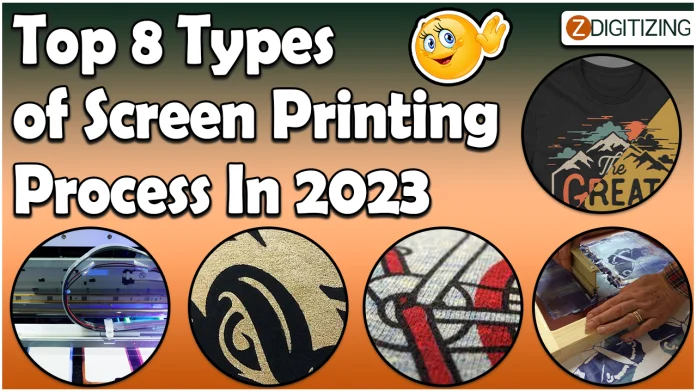Screen printing, also known as silk screening, has been a popular method for transferring designs onto various surfaces for decades. It’s a versatile and cost-effective technique that’s used in various industries, including fashion, advertising, signage, and more. In 2023, screen printing continues to evolve with advancements in technology and creative applications. In this comprehensive guide, we’ll explore the top 8 types of screen printing processes that are making waves in the industry. Whether you’re a screen printing enthusiast, part of an embroidery digitizing company, or simply curious about the world of textile design, read on to discover the latest trends and innovations in screen printing.
1. Traditional Screen Printing
Traditional screen printing, also known as “flatbed” or “flat screen printing,” remains a foundational technique in the industry. It involves creating a stencil or screen with the desired design and then using a squeegee to push ink through the screen onto the substrate. This method is widely used for printing on textiles, paper, plastics, and more.
Applications: Apparel, posters, paper products, signage.
2. Water-Based Screen Printing
Water-based screen printing is an eco-friendly alternative to traditional screen printing. Instead of using solvent-based inks, this method utilizes water-based inks, which are more environmentally friendly and produce a softer print with vibrant colors. Water-based inks are especially popular in the fashion industry for their comfort and sustainability.
Applications: Apparel, eco-friendly products, soft prints.
3. Discharge Screen Printing
Discharge screen printing is a technique that removes or discharges the dye from dyed fabric to create a design. It involves using a discharge agent that reacts with the fabric’s dye, resulting in a faded, vintage look. This method is popular for achieving a soft and breathable print on dark-colored fabrics.
Applications: Apparel, vintage-style designs, dark fabrics.
4. Plastisol Screen Printing
Plastisol screen printing is known for its durability and vibrant colors. It involves using plastisol inks, which are PVC-based and can be cured at lower temperatures. This makes plastisol ideal for printing on a wide range of substrates, including textiles and plastics. It’s a go-to choice for creating bold and long-lasting designs.
Applications: Apparel, promotional products, plastics.
5. High-Density Screen Printing
High-density screen printing is a technique that creates raised or three-dimensional (3D) prints. It involves using a special ink that expands when heated, creating a textured or embossed effect. High-density prints add depth and tactile appeal to designs, making them stand out.
Applications: Apparel, branding, textured designs.
6. All-Over Screen Printing
All-over screen printing, also known as “allover sublimation,” covers the entire surface of a garment or substrate with a design. It’s commonly used to create bold and eye-catching patterns on apparel, including T-shirts, hoodies, and activewear. This method allows for full customization of the entire garment.
Applications: Apparel, fashion, unique patterns.
7. Simulated Process Screen Printing
Simulated process screen printing is a method used for reproducing full-color, photographic, or highly detailed designs. It involves separating the design into a limited number of colors (usually four to six) to simulate a broader color spectrum. This technique is favored for its ability to produce vibrant and detailed prints.
Applications: Apparel, photo-realistic prints, detailed graphics.
8. Glow-in-the-Dark Screen Printing
Glow-in-the-dark screen printing is a specialized technique that uses phosphorescent inks to create designs that glow in the dark. These prints absorb light during the day or under artificial light and emit a soft glow in low-light conditions. They add a fun and unique element to apparel and promotional items.
Applications: Apparel, novelty items, promotional products.
Leveraging Embroidery and Vector Art Services
While screen printing offers a wide range of creative possibilities, it’s essential to highlight the role of embroidery, vector art services, and zdigitizing in the broader context of textile design and customization. These services offer invaluable support in creating and preparing design files for various printing and embroidery methods.
- Embroidery Digitizing Company: When it comes to machine embroidery designs, partnering with a professional embroidery digitizing company ensures that your designs are accurately converted into embroidery-ready formats. This eliminates potential issues related to design clarity and compatibility.
- Vector Art Services: Vector art services play a crucial role in creating clean and scalable design files. These services provide vector files that maintain their quality and clarity even when resized or customized, ensuring consistent and precise printing results.
- zDigitizing: For intricate and complex designs that require precision in both printing and embroidery, zDigitizing services offer the expertise needed to create highly detailed embroidery files. This synergy between zdigitizing and screen printing can result in stunning and cohesive textile designs.
